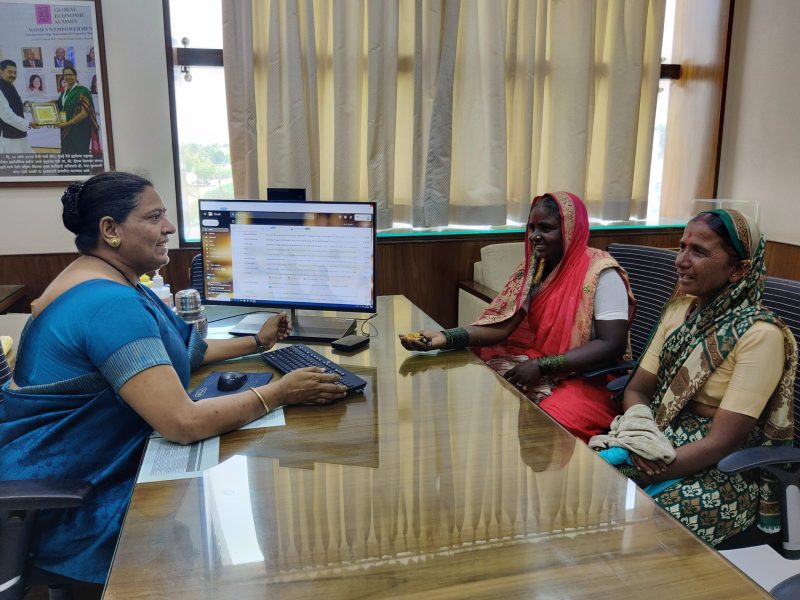
How Mann Deshi Bank, born out of audacity, makes rural women ‘bankable’
Mann Deshi Mahila Sahakari Bank, for and by rural women, was started by Chetna Gala Sinha in 1997; its CEO Rekha Sunil Kulkarni looks back at the bank’s journey, 25 years on

How do you provide banking services to rural women who are usually regarded as unbankable because they do not have collateral? Twenty-five years ago, Chetna Gala Sinha was confronted with this question when a woman blacksmith in Maharashtra’s Mann taluka in Satara district could not park her meagre daily savings with a bank, literally for a rainy day. She wanted to pool her savings to buy a plastic sheet to protect her dwelling during the monsoons.
“Why don’t we start a bank ourselves?” the blacksmith and her unlettered associates asked. Why not, thought Sinha. With that audacity of hope, Sinha and her unlettered group approached the Reserve Bank of India, but their application was turned down because the bank’s promoters were mostly unlettered.

Undaunted, the women returned, learned to read and write and reapplied five months later. This time, they got the licence for Mann Deshi Mahila Sahakari Bank, touted to be the first bank for and by rural women in India. That was in 1997. That was also when Sinha realised that courage can be capital. Sinha has recounted this fascinating story in her 2018 TED talk.
Also read: RBI’s digital rupee may undermine fiat INR and banking sector
Sinha was a Mumbai lady, but romance with a farmer activist brought her to rural Maharashtra, where she lived without creature comforts. The house did not have running water and no toilet either.
No poor solutions
One of the early learnings for Mann Deshi Bank, which celebrates its 25th anniversary this year, was to never provide poor solutions to poor people, its CEO, Rekha Sunil Kulkarni, tells The Federal. How has the bank acted on that principle? Kulkarni says that initially, its depositors would save money in piggy banks, but family members, usually husbands, would grab the money. That resulted in the initiation of doorstep banking where agents visit homes every day and collect the savings. These days, the agents have hand-held digital devices, and depositors get SMS alerts as proof of money deposited.
Doorstep banking also met a felt need as branch visits would mean loss of wages for the bank’s customers. There have been other innovations, too. Like thumb impressions instead of personal identification numbers (PINs) which can be forgotten or stolen.

From a lending of ₹43 lakh in the first year, the bank lent ₹80 crore in 2021-22. This may not seem large, but it has a disproportionate impact because the average loan size was ₹46,800. Last year, there were 17,800 borrowers and they were all women. A fifth of the loans are done to joint liability groups, where members of the group guarantee repayment of interest and principal. The rest are to individuals.
Forty per cent of the loans was to street vendors; 20 per cent was for purchase of goats, sheep, cows and buffaloes; 14 per cent for housing and 8 per cent was against the hypothecation of business assets like utensils, if, say, the business is a canteen.
Also read: Retail inflation eases in Nov; here’s why relief may be short lived
Kulkarni says loans up to ₹1 lakh are unsecured and given against the personal guarantee of two persons. For loans between ₹2-5 lakh, business assets have to be hypothecated and for loans above, the house or landed property has to be given as security.
Cash credit facility
One of the facilities popular with vendors at weekly haats or bazaars is the cash credit facility. Kulkarni says the bank studied the borrowing and repayment practices of the vendors for three months and found that if they borrowed ₹1,000 in the morning, they would pay ₹50 or ₹100 more by the end of the day. But the vendors preferred moneylenders because they would provide the loans when and where needed and had established trust.
The bank’s cash credit facility has obviated the need for the vendors to pay such usurious rates. Before giving the facility, the agents of the bank assess the business of the likely borrower, make enquiries, and start with small sums. They also look at their credit rating score. The interest rate for cash credit and joint liability loans is 22 per cent, lower than the RBI limit of 24 per cent, but higher than that of other loans. This is because of the feet on the ground. Forty-three of the bank’s 69 employees are field workers.
Kulkarni says the bank has access to low-cost funds from depositors. These cost 6-7 per cent. The operational cost is 8-9 per cent. She speaks of borrowers like Vanita Pishe, who started a business of making paper plates and cups and now is an agent for the equipment vendor. Another borrower, Vidya Kirve, has a bag-making unit. Quite a few borrowers like them have risen in life, she says.
Providing skills training
The bank works in tandem with Mann Deshi Foundation, which provides skills training. Women are coached in entrepreneurship, given financial and digital literacy, and taught trades like tailoring. The mobile ‘schools’ are housed in 16 buses. The foundation works in Maharashtra, Gujarat and Karnataka and has touched 8 lakh women, but the bank is confined to eight branches in western Maharashtra.
Among the success stories are goat artificial inseminators. This used to be a male-dominated activity. But now, 45 women do the job. They are also adept at providing other veterinary services and are referred to as goat doctors. To encourage asset transfers to women, the bank gives a rebate of 2 percentage points on interest if the property offered as security is in the name of the woman borrower.
While digital banking has extended the reach of the bank and made banking services convenient, it is unable to recover some of the costs. For example, UPI-based transactions where payment can be made to phone numbers or UPI IDs or QR code scans, the bank has to pay the vendor 65 paise per transaction, but is barred from charging a fee by the RBI.
Spotting a need, Mann Deshi Bank has a pension product for those who cannot rely on their migrant — or uncaring — children in old age. It also provides several insurance products.
Last year, the bank earned a profit of ₹29 lakh on deposits of ₹136 crore and loans of ₹80 crore. Kulkarni says this is because of a provision of ₹1.70 crore for loans that borrowers were unable to repay and had to be restructured. The non-performing loan percentage, though low, had increased because of the pandemic. But the borrowers are making efforts to repay and the reduction in doubtful loans will shore up the bottomline.


